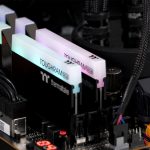You can buy 16GB of Thermaltake RAM running at 3600MHz for £99 or £136 for their RAM running at 4400MHz. Prices fluctuate rapidly in the DDR4 market but it is clear that higher speeds carry a premium. The 4600MHz ToughRAM we are reviewing here currently costs £157 so one question we might address is whether a 200MHz bump is worth an extra £19.
If we approach the specification of this Thermaltake ToughRAM RGB 4600MHz from another direction and look at the 19-26-26-45 1.5V timings we see the figures are potentially rather disappointing. Timings are a key part of the specification and as a result they affect both the performance and the price. We see this when we look at Corsair Vengeance RGB Pro 4000MHz where we can find a 16GB kit with CL19 CAS Latency at £179 while a very similar kit with faster CL18 latency costs £191.
Initial impressions of ToughRAM RGB 4600MHz suggest that Thermaltake has jacked up the clock speed to a headline-grabbing 4600MHz which requires an eye-watering 1.5V. We generally expect to see DDR4 running at 1.35V or possibly 1.4V. The consequence of this quest for high clock speed is a set of timings that look rather slow.
Testing and Performance
To test the Thermaltake ToughRAM RGB 4600MHz we first settled on an Intel Z490 platform, rather than AMD X570. We know full well that AMD is more popular than Intel among the enthusiast DIY market that reads and watches KitGuru content however we are also aware that AMD hardware behaves in a peculiar manner with fast memory. The problem is that once you venture beyond 3600MHz you can find the Infinity Fabric speed cut in half and that can have a significant detrimental effect on performance.
We chose a Gigabyte Z490 Aorus Master, precisely because it is not on Thermaltake's QVL list, as we were confident it would work correctly. In the event that we hit problems we had a supported MSI motherboard on hand but considered it would be quite a story if we found that Thermaltake truly did not support Gigabyte Z490.
The other big decision was the selection of the DDR4 memory used for comparison. Alongside the Thermaltake ToughRAM RGB 4600MHz we also ran some Gigabyte Aorus RGB 4400MHz. Both sets of memory use SK.Hynix D-die and run at very similar XMP speeds. Both kits use a 1.5V setting and have very similar timings with the Thermaltake running 19-26-26-45 and the Gigabyte on 19-26-26-46 so we expected these two kits would be very hard to separate.
In addition we used G.Skill TridentZ Royal 4000MHz which is built on Samsung B-die with timings of 17-17-17-37 at 1.35V.
Our base line DDR4 is the Corsair Vengeance LPX 3600MHz we used in the launch review of Intel Core i9-10900K. The Corsair RAM also uses Samsung B-die and has somewhat slow timings of 16-18-18-36 at 1.35V, however this is a 32GB dual channel kit where the other sets are 16GB. Corsair has managed this neat trick by using a dual rank configuration which effectively means this kit acts like four modules of DDR4.The higher 32GB capacity means this kit typically sells for £290 so the cost per GB is in line with the other kits.
It should be clear the reason for including this 32GB alongside three 16GB kits was to investigate whether clock speed is the main point of differentiation, or whether other factors also play their part. In other words would this ‘slow' 3600MHz kit beat the ‘faster' 4000MHz+ kits.
Test System:
- Processor: Intel Core i9-10900KF (10 cores/20 threads, 4.9GHz all cores)
- CPU Cooler: Fractal Design Celsius S24
- Motherboard: Gigabyte Z490 Aorus Master BIOS f6
- Graphics card: Gigabyte RTX 2080 Super Gaming OC 8G
- Power supply: Seasonic Prime Platinum1300W
- SSD: 1TB Intel 760 M.2 NVMe
- OS: Windows 10\
Be sure to check out our sponsors store EKWB here
 KitGuru KitGuru.net – Tech News | Hardware News | Hardware Reviews | IOS | Mobile | Gaming | Graphics Cards
KitGuru KitGuru.net – Tech News | Hardware News | Hardware Reviews | IOS | Mobile | Gaming | Graphics Cards





